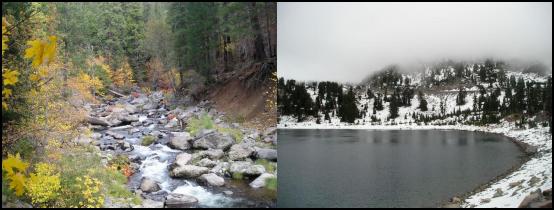Martin LeFevre: Sound and Meditation
Sound and Meditation
by Martin LeFevre
Click to
enlarge
‘One Hour, Two
Seasons.’
On one of the last days of the year before winter sets in in the mountains, I drive up to Lassen Volcanic National Park, the entrance of which is only about an hour and a half from here. Lassen is one of the least visited national parks in America, and is spectacular beyond description.
It’s an amazing thing to go from early autumn at sea level, through full autumn at mid-elevation, and finally, at the pass (at 8500 feet/2600 meters), early winter.
The feeling of wildness at the top is intense, cleansing, and joyous. I’m able to sit for the better part of an hour at Summit Lake on the other side of the pass, at about 7000 feet. As the leading edge of a storm rolls in, the wind howls through the pines, with unknown bird sounds occasionally rising above the noise.
Wavelets lap the shore as I gaze across the small lake upon one of the many ‘minor peaks’ in the park, any one of which would tower over the highest mountains in the East. The essence of one’s meditation practice is this: Opening all the senses in nature and watching the movement of thought/emotion without division.
When I was 17, the direction of my life was set when one’s contemplative and philosophical proclivities converged in the question, asked repeatedly over a period of weeks, ‘what is this observer that always seems to be separate from what it is observing, even in oneself?’ The question, I realized some years later, germinated in the repeated asking, and exploded in an insight that forms the basis of one’s meditation, and I daresay, of meditation itself.
What is that insight? That the observer is a primal, continually generated illusion of thought, the essence of separativeness within the individual, which prevents direct perception, insight, and love. In Christian terms, the separate observer/self is the ‘original sin.’
When there is the deep insight that the observer is part of, indeed inseparable from the movement of thought that it purports to observe, a completely different quality of observation is possible—an observing without the observer. That is, without division.
Back in the Central Valley, the creek is steadily audible about a hundred meters upstream, but the current can barely be heard directly in front of where I sit. Every now and then the water ripples, making a sound like a small fish breaking the surface, though none do so today.
Two groups of boys on bikes go by in quick succession behind me. Their bikes rattle, and they make the kinds of strange, guttural noises that boys often do.
A chainsaw bites through wood in an unseen backyard directly across the stream. It only lasts a second or two, and then stops. A couple minutes later, it happens again, exactly the same way. Fortunately, that’s the last I hear it.
It’s overcast, with the kind of clouds that reflect and intensify both light and sound. Jays squawk, and other birds chirp. A crow caws, and in the distance, a hawk’s cry pierces the air.
Voices of invisible people passing along the park road across the creek sound crisp and clear, as if one is in the same quiet room with them. It reminds me of the chair in a concave chamber in the San Francisco Museum of Science, which focuses even whispers from the other side of the huge room to where one sits.
Our individual consciousness is as inseparable from collective consciousness as eddies are from a river.
In a dead culture such as this, meditation is not a luxury, but a matter of inward survival. Even in an intact culture, a person cannot grow into a human being without space and silence for observation and reflection. Continuous reaction is the way of machines, which most people seem content to become.
Methods, techniques, rituals, and habituated practices are antithetical to awakening meditation because all these things are born of thought, and thought cannot be used to quiet thought.
Sound is the best teacher of meditation, because we don’t direct our hearing as we do our sight, and if one really listens, without judging or even naming, the mind naturally grows quiet as attention effortlessly gathers in the brain.
Through fully and undividedly attending to the movement of thought/emotion in methodless meditation, the chattering mind ends. Then one leaves the littered valley, and enters into the vastness of the cosmic mind.
Human beings are not meant to be encrusted accretions of experience and knowledge, but transparent windows for the sublime and sacred.
Martin LeFevre is a contemplative and philosopher. More of his work and an archive can be found at the Colorado-based site Fountain of Light (fountainoflight.net). martinlefevre@sbcglobal.net


 Eugene Doyle: Has WWIII Started?
Eugene Doyle: Has WWIII Started? Binoy Kampmark: Fencing The Ocean - Australia’s Social Media Safety Bill
Binoy Kampmark: Fencing The Ocean - Australia’s Social Media Safety Bill Binoy Kampmark: Trump, AUKUS And Australia’s Dim Servitors
Binoy Kampmark: Trump, AUKUS And Australia’s Dim Servitors Peter Dunne: Dunne's Weekly - The Wrong Answer To A Question That Does Not Exist
Peter Dunne: Dunne's Weekly - The Wrong Answer To A Question That Does Not Exist Martin LeFevre - Meditations: Perception, Conception And Beauty
Martin LeFevre - Meditations: Perception, Conception And Beauty Alastair Thompson: On The Publication Of The First NCQG Text 'New Collective Quantified Goal On Climate Finance'
Alastair Thompson: On The Publication Of The First NCQG Text 'New Collective Quantified Goal On Climate Finance'